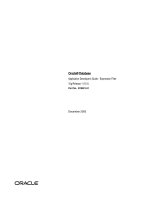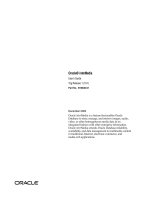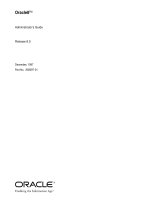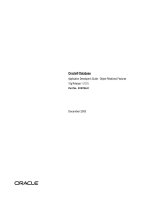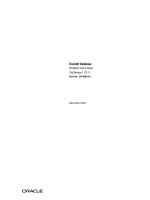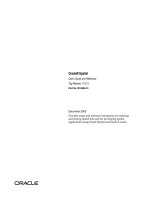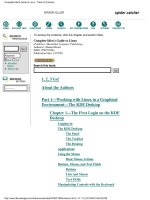Tài liệu PL/SQL User''''s Guide and Reference pdf
Bạn đang xem bản rút gọn của tài liệu. Xem và tải ngay bản đầy đủ của tài liệu tại đây (5.69 MB, 492 trang )
PL/SQL
User's Guide and Reference
10g Release 1 (10.1)
Part No. B10807-01
December 2003
PL/SQL User's Guide and Reference, 10g Release 1 (10.1)
Part No. B10807-01
Copyright © 1996, 2003 Oracle. All rights reserved.
Primary Author: John Russell
Contributors: Shashaanka Agrawal, Cailein Barclay, Dmitri Bronnikov, Sharon Castledine, Thomas
Chang, Ravindra Dani, Chandrasekharan Iyer, Susan Kotsovolos, Neil Le, Warren Li, Bryn Llewellyn, Chris
Racicot, Murali Vemulapati, Guhan Viswanathan, Minghui Yang
The Programs (which include both the software and documentation) contain proprietary information; they
are provided under a license agreement containing restrictions on use and disclosure and are also protected
by copyright, patent, and other intellectual and industrial property laws. Reverse engineering, disassembly,
or decompilation of the Programs, except to the extent required to obtain interoperability with other
independently created software or as specified by law, is prohibited.
The information contained in this document is subject to change without notice. If you find any problems in
the documentation, please report them to us in writing. This document is not warranted to be error-free.
Except as may be expressly permitted in your license agreement for these Programs, no part of these
Programs may be reproduced or transmitted in any form or by any means, electronic or mechanical, for any
purpose.
If the Programs are delivered to the United States Government or anyone licensing or using the Programs on
behalf of the United States Government, the following notice is applicable:
U.S. GOVERNMENT RIGHTS Programs, software, databases, and related documentation and technical data
delivered to U.S. Government customers are "commercial computer software" or "commercial technical
data" pursuant to the applicable Federal Acquisition Regulation and agency-specific supplemental
regulations. As such, use, duplication, disclosure, modification, and adaptation of the Programs, including
documentation and technical data, shall be subject to the licensing restrictions set forth in the applicable
Oracle license agreement, and, to the extent applicable, the additional rights set forth in FAR 52.227-19,
Commercial Computer Software Restricted Rights (June 1987). Oracle Corporation, 500 Oracle Parkway,
Redwood City, CA 94065
The Programs are not intended for use in any nuclear, aviation, mass transit, medical, or other inherently
dangerous applications. It shall be the licensee's responsibility to take all appropriate fail-safe, backup,
redundancy and other measures to ensure the safe use of such applications if the Programs are used for such
purposes, and we disclaim liability for any damages caused by such use of the Programs.
Oracle is a registered trademark of Oracle Corporation and/or its affiliates. Other names may be trademarks
of their respective owners.
The Programs may provide links to Web sites and access to content, products, and services from third
parties. Oracle is not responsible for the availability of, or any content provided on, third-party Web sites.
You bear all risks associated with the use of such content. If you choose to purchase any products or services
from a third party, the relationship is directly between you and the third party. Oracle is not responsible for:
(a) the quality of third-party products or services; or (b) fulfilling any of the terms of the agreement with the
third party, including delivery of products or services and warranty obligations related to purchased
products or services. Oracle is not responsible for any loss or damage of any sort that you may incur from
dealing with any third party.
iii
Contents
Send Us Your Comments xv
Preface xvii
Audience xvii
How This Book Is Organized xvii
Related Documentation xix
Conventions xx
Sample Database Tables xxi
Documentation Accessibility xxii
Reading the Syntax Diagrams xxii
What's New in PL/SQL? xxiii
New Features in PL/SQL for Oracle Database 10g xxiii
New Features in PL/SQL for Oracle9i xxvi
1 Overview of PL/SQL
Advantages of PL/SQL 1-1
Tight Integration with SQL 1-1
Support for SQL 1-2
Better Performance 1-2
Higher Productivity 1-3
Full Portability 1-3
Tight Security 1-3
Support for Object-Oriented Programming 1-3
Understanding the Main Features of PL/SQL 1-4
Block Structure 1-4
Variables and Constants 1-5
Processing Queries with PL/SQL 1-6
Declaring PL/SQL Variables 1-6
Control Structures 1-7
Writing Reusable PL/SQL Code 1-9
Data Abstraction 1-10
Error Handling 1-12
PL/SQL Architecture 1-12
In the Oracle Database Server 1-13
iv
In Oracle Tools 1-14
2 Fundamentals of the PL/SQL Language
Character Set 2-1
Lexical Units 2-1
Delimiters 2-2
Identifiers 2-3
Literals 2-4
Comments 2-7
Declarations 2-8
Using DEFAULT 2-9
Using NOT NULL 2-9
Using the %TYPE Attribute 2-9
Using the %ROWTYPE Attribute 2-10
Restrictions on Declarations 2-12
PL/SQL Naming Conventions 2-12
Scope and Visibility of PL/SQL Identifiers 2-14
Assigning Values to Variables 2-16
Assigning Boolean Values 2-17
Assigning a SQL Query Result to a PL/SQL Variable 2-17
PL/SQL Expressions and Comparisons 2-17
Logical Operators 2-18
Boolean Expressions 2-21
CASE Expressions 2-24
Handling Null Values in Comparisons and Conditional Statements 2-25
Summary of PL/SQL Built-In Functions 2-28
3 PL/SQL Datatypes
Overview of Predefined PL/SQL Datatypes 3-1
PL/SQL Number Types 3-2
PL/SQL Character and String Types 3-4
PL/SQL National Character Types 3-8
PL/SQL LOB Types 3-10
PL/SQL Boolean Types 3-11
PL/SQL Date, Time, and Interval Types 3-12
Datetime and Interval Arithmetic 3-15
Avoiding Truncation Problems Using Date and Time Subtypes 3-16
Overview of PL/SQL Subtypes 3-16
Defining Subtypes 3-16
Using Subtypes 3-17
Converting PL/SQL Datatypes 3-18
Explicit Conversion 3-18
Implicit Conversion 3-18
Choosing Between Implicit and Explicit Conversion 3-20
DATE Values 3-20
RAW and LONG RAW Values 3-20
v
4 Using PL/SQL Control Structures
Overview of PL/SQL Control Structures 4-1
Testing Conditions: IF and CASE Statements 4-2
Using the IF-THEN Statement 4-2
Using the IF-THEN-ELSE Statement 4-2
Using the IF-THEN-ELSIF Statement 4-3
Using the CASE Statement 4-3
Guidelines for PL/SQL Conditional Statements 4-5
Controlling Loop Iterations: LOOP and EXIT Statements 4-6
Using the LOOP Statement 4-6
Using the EXIT Statement 4-7
Using the EXIT-WHEN Statement 4-7
Labeling a PL/SQL Loop 4-7
Using the WHILE-LOOP Statement 4-8
Using the FOR-LOOP Statement 4-9
Sequential Control: GOTO and NULL Statements 4-12
Using the GOTO Statement 4-12
Using the NULL Statement 4-13
5 Using PL/SQL Collections and Records
What Is a Collection? 5-1
Understanding Nested Tables 5-2
Understanding Varrays 5-2
Understanding Associative Arrays (Index-By Tables) 5-3
How Globalization Settings Affect VARCHAR2 Keys for Associative Arrays 5-4
Choosing Which PL/SQL Collection Types to Use 5-4
Choosing Between Nested Tables and Associative Arrays 5-5
Choosing Between Nested Tables and Varrays 5-5
Defining Collection Types 5-6
Defining SQL Types Equivalent to PL/SQL Collection Types 5-7
Declaring PL/SQL Collection Variables 5-8
Initializing and Referencing Collections 5-10
Referencing Collection Elements 5-12
Assigning Collections 5-13
Comparing Collections 5-16
Using PL/SQL Collections with SQL Statements 5-17
Using PL/SQL Varrays with INSERT, UPDATE, and SELECT Statements 5-20
Manipulating Individual Collection Elements with SQL 5-21
Using Multilevel Collections 5-21
Using Collection Methods 5-23
Checking If a Collection Element Exists (EXISTS Method) 5-24
Counting the Elements in a Collection (COUNT Method) 5-24
Checking the Maximum Size of a Collection (LIMIT Method) 5-24
Finding the First or Last Collection Element (FIRST and LAST Methods) 5-25
Looping Through Collection Elements (PRIOR and NEXT Methods) 5-26
Increasing the Size of a Collection (EXTEND Method) 5-27
vi
Decreasing the Size of a Collection (TRIM Method) 5-28
Deleting Collection Elements (DELETE Method) 5-29
Applying Methods to Collection Parameters 5-30
Avoiding Collection Exceptions 5-30
What Is a PL/SQL Record? 5-32
Defining and Declaring Records 5-32
Using Records as Procedure Parameters and Function Return Values 5-33
Assigning Values to Records 5-34
Comparing Records 5-35
Inserting PL/SQL Records into the Database 5-36
Updating the Database with PL/SQL Record Values 5-36
Restrictions on Record Inserts/Updates 5-37
Querying Data into Collections of Records 5-38
6 Performing SQL Operations from PL/SQL
Overview of SQL Support in PL/SQL 6-1
Data Manipulation 6-1
Transaction Control 6-2
SQL Functions 6-2
SQL Pseudocolumns 6-2
SQL Operators 6-4
Performing DML Operations from PL/SQL (INSERT, UPDATE, and DELETE) 6-5
Overview of Implicit Cursor Attributes 6-6
Using PL/SQL Records in SQL INSERT and UPDATE Statements 6-7
Issuing Queries from PL/SQL 6-7
Selecting At Most One Row: SELECT INTO Statement 6-7
Selecting Multiple Rows: BULK COLLECT Clause 6-8
Looping Through Multiple Rows: Cursor FOR Loop 6-8
Performing Complicated Query Processing: Explicit Cursors 6-8
Querying Data with PL/SQL 6-9
Querying Data with PL/SQL: Implicit Cursor FOR Loop 6-9
Querying Data with PL/SQL: Explicit Cursor FOR Loops 6-9
Defining Aliases for Expression Values in a Cursor FOR Loop 6-10
Overview of Explicit Cursors 6-10
Using Subqueries 6-13
Using Correlated Subqueries 6-15
Writing Maintainable PL/SQL Queries 6-15
Using Cursor Attributes 6-16
Overview of Explicit Cursor Attributes 6-16
Using Cursor Variables (REF CURSORs) 6-19
What Are Cursor Variables (REF CURSORs)? 6-19
Why Use Cursor Variables? 6-19
Declaring REF CURSOR Types and Cursor Variables 6-20
Controlling Cursor Variables: OPEN-FOR, FETCH, and CLOSE 6-22
Reducing Network Traffic When Passing Host Cursor Variables to PL/SQL 6-26
Avoiding Errors with Cursor Variables 6-26
Restrictions on Cursor Variables 6-27
vii
Using Cursor Expressions 6-27
Restrictions on Cursor Expressions 6-28
Example of Cursor Expressions 6-28
Constructing REF CURSORs with Cursor Subqueries 6-29
Overview of Transaction Processing in PL/SQL 6-29
Using COMMIT, SAVEPOINT, and ROLLBACK in PL/SQL 6-29
How Oracle Does Implicit Rollbacks 6-31
Ending Transactions 6-31
Setting Transaction Properties with SET TRANSACTION 6-32
Overriding Default Locking 6-32
Doing Independent Units of Work with Autonomous Transactions 6-35
Advantages of Autonomous Transactions 6-35
Defining Autonomous Transactions 6-35
Controlling Autonomous Transactions 6-37
Using Autonomous Triggers 6-38
Calling Autonomous Functions from SQL 6-39
7 Performing SQL Operations with Native Dynamic SQL
What Is Dynamic SQL? 7-1
Why Use Dynamic SQL? 7-2
Using the EXECUTE IMMEDIATE Statement 7-2
Specifying Parameter Modes for Bind Variables in Dynamic SQL Strings 7-4
Building a Dynamic Query with Dynamic SQL 7-4
Examples of Dynamic SQL for Records, Objects, and Collections 7-5
Using Bulk Dynamic SQL 7-6
Using Dynamic SQL with Bulk SQL 7-6
Examples of Dynamic Bulk Binds 7-7
Guidelines for Dynamic SQL 7-8
When to Use or Omit the Semicolon with Dynamic SQL 7-8
Improving Performance of Dynamic SQL with Bind Variables 7-8
Passing Schema Object Names As Parameters 7-9
Using Duplicate Placeholders with Dynamic SQL 7-9
Using Cursor Attributes with Dynamic SQL 7-10
Passing Nulls to Dynamic SQL 7-10
Using Database Links with Dynamic SQL 7-10
Using Invoker Rights with Dynamic SQL 7-11
Using Pragma RESTRICT_REFERENCES with Dynamic SQL 7-11
Avoiding Deadlocks with Dynamic SQL 7-12
Backward Compatibility of the USING Clause 7-12
8 Using PL/SQL Subprograms
What Are Subprograms? 8-1
Advantages of PL/SQL Subprograms 8-2
Understanding PL/SQL Procedures 8-3
Understanding PL/SQL Functions 8-3
Using the RETURN Statement 8-4
viii
Declaring Nested PL/SQL Subprograms 8-5
Passing Parameters to PL/SQL Subprograms 8-6
Actual Versus Formal Subprogram Parameters 8-6
Using Positional, Named, or Mixed Notation for Subprogram Parameters 8-7
Specifying Subprogram Parameter Modes 8-7
Using Default Values for Subprogram Parameters 8-9
Overloading Subprogram Names 8-9
Guidelines for Overloading with Numeric Types 8-11
Restrictions on Overloading 8-11
How Subprogram Calls Are Resolved 8-12
How Overloading Works with Inheritance 8-13
Using Invoker's Rights Versus Definer's Rights (AUTHID Clause) 8-15
Advantages of Invoker's Rights 8-15
Specifying the Privileges for a Subprogram with the AUTHID Clause 8-16
Who Is the Current User During Subprogram Execution? 8-16
How External References Are Resolved in Invoker's Rights Subprograms 8-16
Overriding Default Name Resolution in Invoker's Rights Subprograms 8-17
Granting Privileges on Invoker's Rights Subprograms 8-17
Using Roles with Invoker's Rights Subprograms 8-18
Using Views and Database Triggers with Invoker's Rights Subprograms 8-18
Using Database Links with Invoker's Rights Subprograms 8-18
Using Object Types with Invoker's Rights Subprograms 8-19
Using Recursion with PL/SQL 8-20
What Is a Recursive Subprogram? 8-20
Calling External Subprograms 8-21
Creating Dynamic Web Pages with PL/SQL Server Pages 8-22
Controlling Side Effects of PL/SQL Subprograms 8-22
Understanding Subprogram Parameter Aliasing 8-23
9 Using PL/SQL Packages
What Is a PL/SQL Package? 9-2
What Goes In a PL/SQL Package? 9-2
Example of a PL/SQL Package 9-3
Advantages of PL/SQL Packages 9-3
Understanding The Package Specification 9-4
Referencing Package Contents 9-5
Understanding The Package Body 9-6
Some Examples of Package Features 9-7
Private Versus Public Items in Packages 9-11
Overloading Packaged Subprograms 9-11
How Package STANDARD Defines the PL/SQL Environment 9-12
Overview of Product-Specific Packages 9-12
About the DBMS_ALERT Package 9-12
About the DBMS_OUTPUT Package 9-12
About the DBMS_PIPE Package 9-13
About the UTL_FILE Package 9-13
About the UTL_HTTP Package 9-13
ix
Guidelines for Writing Packages 9-13
Separating Cursor Specs and Bodies with Packages 9-14
10 Handling PL/SQL Errors
Overview of PL/SQL Runtime Error Handling 10-1
Guidelines for Avoiding and Handling PL/SQL Errors and Exceptions 10-3
Advantages of PL/SQL Exceptions 10-3
Summary of Predefined PL/SQL Exceptions 10-4
Defining Your Own PL/SQL Exceptions 10-6
Declaring PL/SQL Exceptions 10-6
Scope Rules for PL/SQL Exceptions 10-6
Associating a PL/SQL Exception with a Number: Pragma EXCEPTION_INIT 10-7
Defining Your Own Error Messages: Procedure RAISE_APPLICATION_ERROR 10-8
Redeclaring Predefined Exceptions 10-9
How PL/SQL Exceptions Are Raised 10-9
Raising Exceptions with the RAISE Statement 10-9
How PL/SQL Exceptions Propagate 10-10
Reraising a PL/SQL Exception 10-12
Handling Raised PL/SQL Exceptions 10-12
Handling Exceptions Raised in Declarations 10-13
Handling Exceptions Raised in Handlers 10-14
Branching to or from an Exception Handler 10-14
Retrieving the Error Code and Error Message: SQLCODE and SQLERRM 10-14
Catching Unhandled Exceptions 10-15
Tips for Handling PL/SQL Errors 10-15
Continuing after an Exception Is Raised 10-15
Retrying a Transaction 10-16
Using Locator Variables to Identify Exception Locations 10-17
Overview of PL/SQL Compile-Time Warnings 10-17
PL/SQL Warning Categories 10-18
Controlling PL/SQL Warning Messages 10-18
Using the DBMS_WARNING Package 10-19
11 Tuning PL/SQL Applications for Performance
How PL/SQL Optimizes Your Programs 11-1
When to Tune PL/SQL Code 11-1
Guidelines for Avoiding PL/SQL Performance Problems 11-2
Avoiding CPU Overhead in PL/SQL Code 11-2
Avoiding Memory Overhead in PL/SQL Code 11-5
Profiling and Tracing PL/SQL Programs 11-6
Using The Profiler API: Package DBMS_PROFILER 11-6
Using The Trace API: Package DBMS_TRACE 11-7
Reducing Loop Overhead for DML Statements and Queries (FORALL, BULK COLLECT). 11-7
Using the FORALL Statement 11-8
Retrieving Query Results into Collections with the BULK COLLECT Clause 11-15
Writing Computation-Intensive Programs in PL/SQL 11-19
x
Tuning Dynamic SQL with EXECUTE IMMEDIATE and Cursor Variables 11-19
Tuning PL/SQL Procedure Calls with the NOCOPY Compiler Hint 11-20
Restrictions on NOCOPY 11-21
Compiling PL/SQL Code for Native Execution 11-22
Setting Up Transformation Pipelines with Table Functions 11-28
Overview of Table Functions 11-28
Using Pipelined Table Functions for Transformations 11-30
Writing a Pipelined Table Function 11-31
Returning Results from Table Functions 11-31
Pipelining Data Between PL/SQL Table Functions 11-32
Querying Table Functions 11-32
Optimizing Multiple Calls to Table Functions 11-33
Fetching from the Results of Table Functions 11-33
Passing Data with Cursor Variables 11-33
Performing DML Operations Inside Table Functions 11-35
Performing DML Operations on Table Functions 11-35
Handling Exceptions in Table Functions 11-36
12 Using PL/SQL Object Types
Overview of PL/SQL Object Types 12-1
What Is an Object Type? 12-2
Why Use Object Types? 12-3
Structure of an Object Type 12-3
Components of an Object Type 12-5
What Languages can I Use for Methods of Object Types? 12-6
How Object Types Handle the SELF Parameter 12-6
Overloading 12-7
Changing Attributes and Methods of an Existing Object Type (Type Evolution) 12-9
Defining Object Types 12-9
Overview of PL/SQL Type Inheritance 12-10
Declaring and Initializing Objects 12-11
Declaring Objects 12-11
Initializing Objects 12-12
How PL/SQL Treats Uninitialized Objects 12-12
Accessing Object Attributes 12-13
Defining Object Constructors 12-13
Calling Object Constructors 12-14
Calling Object Methods 12-15
Sharing Objects through the REF Modifier 12-16
Forward Type Definitions 12-17
Manipulating Objects through SQL 12-17
Selecting Objects 12-18
Inserting Objects 12-21
Updating Objects 12-22
Deleting Objects 12-22
xi
13 PL/SQL Language Elements
Assignment Statement 13-3
AUTONOMOUS_TRANSACTION Pragma 13-6
Blocks 13-8
CASE Statement 13-14
CLOSE Statement 13-16
Collection Methods 13-17
Collections 13-21
Comments 13-26
COMMIT Statement 13-27
Constants and Variables 13-28
Cursor Attributes 13-31
Cursor Variables 13-34
Cursors 13-38
DELETE Statement 13-41
EXCEPTION_INIT Pragma 13-44
Exceptions 13-45
EXECUTE IMMEDIATE Statement 13-47
EXIT Statement 13-50
Expressions 13-52
FETCH Statement 13-60
FORALL Statement 13-64
Functions 13-67
GOTO Statement 13-71
IF Statement 13-72
INSERT Statement 13-74
Literals 13-76
LOCK TABLE Statement 13-78
LOOP Statements 13-79
MERGE Statement 13-84
NULL Statement 13-85
Object Types 13-86
OPEN Statement 13-93
OPEN-FOR Statement 13-95
OPEN-FOR-USING Statement 13-97
Packages 13-99
Procedures 13-104
RAISE Statement 13-108
Records 13-110
RESTRICT_REFERENCES Pragma 13-113
RETURN Statement 13-115
ROLLBACK Statement 13-117
%ROWTYPE Attribute 13-119
SAVEPOINT Statement 13-121
SCN_TO_TIMESTAMP Function 13-122
SELECT INTO Statement 13-123
SERIALLY_REUSABLE Pragma 13-127
xii
SET TRANSACTION Statement 13-129
SQL Cursor 13-131
SQLCODE Function 13-135
SQLERRM Function 13-136
TIMESTAMP_TO_SCN Function 13-138
%TYPE Attribute 13-139
UPDATE Statement 13-141
A Sample PL/SQL Programs
Where to Find PL/SQL Sample Programs A-1
Exercises for the Reader A-1
B Understanding CHAR and VARCHAR2 Semantics in PL/SQL
Assigning Character Values B-1
Comparing Character Values B-2
Inserting Character Values B-2
Selecting Character Values B-3
C Obfuscating Source Code with the PL/SQL Wrap Utility
Advantages of Wrapping PL/SQL Procedures C-1
Running the PL/SQL Wrap Utility C-1
Input and Output Files for the PL/SQL Wrap Utility C-2
Limitations of the PL/SQL Wrap Utility C-3
D How PL/SQL Resolves Identifier Names
What Is Name Resolution? D-1
Examples of Qualified Names and Dot Notation D-2
Differences in Name Resolution Between SQL and PL/SQL D-3
Understanding Capture D-3
Inner Capture D-3
Same-Scope Capture D-4
Outer Capture D-4
Avoiding Inner Capture in DML Statements D-4
Qualifying References to Object Attributes and Methods D-5
Calling Parameterless Subprograms and Methods D-5
Name Resolution for SQL Versus PL/SQL D-6
E PL/SQL Program Limits
F List of PL/SQL Reserved Words
G Frequently Asked Questions About PL/SQL
When Should I Use Bind Variables with PL/SQL? G-1
When Do I Use or Omit the Semicolon with Dynamic SQL? G-1
How Can I Use Regular Expressions with PL/SQL? G-1
xiii
How Do I Continue After a PL/SQL Exception? G-2
Does PL/SQL Have User-Defined Types or Abstract Data Types? G-2
How Do I Pass a Result Set from PL/SQL to Java or Visual Basic (VB)? G-2
How Do I Specify Different Kinds of Names with PL/SQL's Dot Notation? G-2
What Can I Do with Objects and Object Types in PL/SQL? G-3
How Do I Create a PL/SQL Procedure? G-3
How Do I Input or Output Data with PL/SQL? G-4
How Do I Perform a Case-Insensitive Query? G-4
Index
xiv
xv
Send Us Your Comments
PL/SQL User's Guide and Reference, 10g Release 1 (10.1)
Part No. B10807-01
Oracle welcomes your comments and suggestions on the quality and usefulness of this
publication. Your input is an important part of the information used for revision.
■ Did you find any errors?
■ Is the information clearly presented?
■ Do you need more information? If so, where?
■ Are the examples correct? Do you need more examples?
■ What features did you like most about this manual?
If you find any errors or have any other suggestions for improvement, please indicate
the title and part number of the documentation and the chapter, section, and page
number (if available). You can send comments to us in the following ways:
■ Electronic mail:
■ FAX: (650) 506-7227. Attn: Server Technologies Documentation Manager
■ Postal service:
Oracle Corporation
Server Technologies Documentation Manager
500 Oracle Parkway, Mailstop 4op11
Redwood Shores, CA 94065
USA
If you would like a reply, please give your name, address, telephone number, and
electronic mail address (optional).
If you have problems with the software, please contact your local Oracle Support
Services.
xvi
xvii
Preface
This guide explains the concepts behind the PL/SQL language and shows, with
examples, how to use various language features.
This preface contains these topics:
■ Audience
■ How This Book Is Organized
■ Related Documentation
■ Conventions
■ Sample Database Tables
■ Documentation Accessibility
■ Reading the Syntax Diagrams
Audience
PL/SQL, Oracle's procedural extension of SQL, is an advanced fourth-generation
programming language (4GL). It offers software-engineering features such as data
encapsulation, overloading, collection types, exceptions, and information hiding.
PL/SQL also supports rapid prototyping and development through tight integration
with SQL and the Oracle database.
Anyone developing PL/SQL-based applications for Oracle should read this book. This
book is intended for programmers, systems analysts, project managers, database
administrators, and others who need to automate database operations. People
developing applications in other languages can also produce mixed-language
applications with parts written in PL/SQL.
To use this guide effectively, you need a working knowledge of the Oracle database,
the SQL language, and basic programming constructs such as IF-THEN comparisons,
loops, and procedures and functions.
How This Book Is Organized
The PL/SQL User's Guide and Reference contains:
Getting Started with PL/SQL
Chapter 1, "Overview of PL/SQL"
Summarizes the main features of PL/SQL and their advantages. Introduces the basic
concepts behind PL/SQL and the general appearance of PL/SQL programs.
xviii
Chapter 2, "Fundamentals of the PL/SQL Language"
Focuses on the small-scale aspects of PL/SQL: lexical units, scalar datatypes,
user-defined subtypes, data conversion, expressions, assignments, block structure,
declarations, and scope.
Chapter 3, "PL/SQL Datatypes"
Discusses PL/SQL's predefined datatypes, which include integer, floating-point,
character, Boolean, date, collection, reference, and LOB types. Also discusses
user-defined subtypes and data conversion.
Chapter 4, "Using PL/SQL Control Structures"
Shows how to control the flow of execution through a PL/SQL program. Describes
conditional, iterative, and sequential control, with control structures such as
IF-THEN-ELSE, CASE, and WHILE-LOOP.
Chapter 5, "Using PL/SQL Collections and Records"
Discusses the composite datatypes TABLE, VARRAY, and RECORD. You learn how to
reference and manipulate whole collections of data and group data of different types
together.
Database Programming with PL/SQL
Chapter 6, "Performing SQL Operations from PL/SQL"
Shows how PL/SQL supports the SQL commands, functions, and operators for
manipulating Oracle data. Also shows how to process queries and transactions.
Chapter 7, "Performing SQL Operations with Native Dynamic SQL"
Shows how to build SQL statements and queries at run time.
Software Engineering with PL/SQL
Chapter 8, "Using PL/SQL Subprograms"
Shows how to write and call procedures, functions. It discusses related topics such as
parameters, overloading, and different privilege models for subprograms.
Chapter 9, "Using PL/SQL Packages"
Shows how to bundle related PL/SQL types, items, and subprograms into a package.
Packages define APIs that can be reused by many applications.
Chapter 10, "Handling PL/SQL Errors"
Shows how to detect and handle PL/SQL errors using exceptions and handlers.
Chapter 11, "Tuning PL/SQL Applications for Performance"
Shows how to improve performance for PL/SQL-based applications.
Chapter 12, "Using PL/SQL Object Types"
Introduces object-oriented programming based on object types. You learn how to write
object methods and manipulate objects through PL/SQL.
PL/SQL Language Reference
Chapter 13, "PL/SQL Language Elements"
Shows the syntax of statements, parameters, and other PL/SQL language elements.
Also includes usage notes and short examples.
xix
Appendixes
Appendix A, "Sample PL/SQL Programs"
Provides several PL/SQL programs to guide you in writing your own. The sample
programs illustrate important concepts and features.
Appendix B, "Understanding CHAR and VARCHAR2 Semantics in PL/SQL"
Explains the subtle but important semantic differences between the CHAR and
VARCHAR2 base types.
Appendix C, "Obfuscating Source Code with the PL/SQL Wrap Utility"
Shows you how to run the Wrap Utility, a standalone programming utility that enables
you to deliver PL/SQL applications without exposing your source code.
Appendix D, "How PL/SQL Resolves Identifier Names"
Explains how PL/SQL resolves references to names in potentially ambiguous SQL and
procedural statements.
Appendix E, "PL/SQL Program Limits"
Explains the compile-time and runtime limits imposed by PL/SQL .
Appendix F, "List of PL/SQL Reserved Words"
Lists the words that are reserved for use by PL/SQL.
Appendix G, "Frequently Asked Questions About PL/SQL"
Provides tips and answers to some of the most common PL/SQL questions.
Related Documentation
For more information, see these Oracle resources:
Various aspects of PL/SQL programming, in particular details for triggers and stored
procedures, are covered in Oracle Database Application Developer's Guide - Fundamentals
For extensive information on object-oriented programming using both PL/SQL and
SQL features, see Oracle Database Application Developer's Guide - Object-Relational
Features
For information about programming with large objects (LOBs), see Oracle Database
Application Developer's Guide - Large Objects
For SQL information, see the Oracle Database SQL Reference and Oracle Database
Administrator's Guide. For basic Oracle concepts, see Oracle Database Concepts.
Printed documentation is available for sale in the Oracle Store at
/>To download free release notes, installation documentation, white papers, or other
collateral, please visit the Oracle Technology Network (OTN). You must register online
before using OTN; registration is free and can be done at
/>If you already have a username and password for OTN, then you can go directly to the
documentation section of the OTN Web site at
/>xx
Conventions
This section describes the conventions used in the text and code examples of this
documentation set. It describes:
■ Conventions in Text
■ Conventions in Code Examples
Conventions in Text
We use various conventions in text to help you more quickly identify special terms.
The following table describes those conventions and provides examples of their use.
Conventions in Code Examples
Code examples illustrate SQL, PL/SQL, SQL*Plus, or other command-line statements.
They are displayed in a monospace (fixed-width) font and separated from normal text
as shown in this example:
SELECT username FROM dba_users WHERE username = 'MIGRATE';
The following table describes typographic conventions used in code examples and
provides examples of their use.
Convention Meaning Example
Bold Bold typeface indicates terms that are
defined in the text or terms that appear in
a glossary, or both.
When you specify this clause, you create an
index-organized table.
Italics Italic typeface indicates book titles or
emphasis.
Oracle Database Concepts
Ensure that the recovery catalog and target
database do not reside on the same disk.
UPPERCASE
monospace
(fixed-width
font)
Uppercase monospace typeface indicates
elements supplied by the system. Such
elements include parameters, privileges,
datatypes, RMAN keywords, SQL
keywords, SQL*Plus or utility commands,
packages and methods, as well as
system-supplied column names, database
objects and structures, usernames, and
roles.
You can specify this clause only for a NUMBER
column.
You can back up the database by using the
BACKUP command.
Query the TABLE_NAME column in the USER_
TABLES data dictionary view.
Use the DBMS_STATS.GENERATE_STATS
procedure.
lowercase
monospace
(fixed-width
font)
Lowercase monospace typeface indicates
executables, filenames, directory names,
and sample user-supplied elements. Such
elements include computer and database
names, net service names, and connect
identifiers, as well as user-supplied
database objects and structures, column
names, packages and classes, usernames
and roles, program units, and parameter
values.
Note: Some programmatic elements use a
mixture of UPPERCASE and lowercase.
Enter these elements as shown.
Enter sqlplus to open SQL*Plus.
The password is specified in the orapwd file.
Back up the datafiles and control files in the
/disk1/oracle/dbs directory.
The department_id,department_name, and
location_id columns are in the
hr.departments table.
SettheQUERY_REWRITE_ENABLEDinitialization
parameter to true.
Connect as oe user.
The JRepUtil class implements these methods.
lowercase
monospace
(fixed-width
font) italic
Lowercase monospace italic font
represents placeholders or variables.
You can specify the parallel_clause.
RunUold_release.SQL whereold_release
refers to the release you installed prior to
upgrading.
xxi
Sample Database Tables
Some programming examples in this guide use tables and other objects from the HR
schema of the sample database. These tables, such as EMPLOYEES and DEPARTMENTS,
Convention Meaning Example
[ ] Brackets enclose one or more optional
items. Do not enter the brackets.
DECIMAL (digits [ , precision ])
{ } Braces enclose two or more items, one of
which is required. Do not enter the
braces.
{ENABLE | DISABLE}
| A vertical bar represents a choice of two
or more options within brackets or braces.
Enter one of the options. Do not enter the
vertical bar.
{ENABLE | DISABLE}
[COMPRESS | NOCOMPRESS]
Horizontal ellipsis points indicate either:
■ That we have omitted parts of the
code that are not directly related to
the example
■ That you can repeat a portion of the
code
CREATE TABLE AS subquery;
SELECT col1, col2, , coln FROM
employees;
.
.
.
Vertical ellipsis points indicate that we
have omitted several lines of code not
directly related to the example.
Other notation You must enter symbols other than
brackets, braces, vertical bars, and ellipsis
points as shown.
acctbal NUMBER(11,2);
acct CONSTANT NUMBER(4) := 3;
Italics Italicized text indicates placeholders or
variables for which you must supply
particular values.
CONNECT SYSTEM/system_password
DB_NAME = database_name
UPPERCASE Uppercase typeface indicates elements
supplied by the system. We show these
terms in uppercase in order to distinguish
them from terms you define. Unless terms
appear in brackets, enter them in the
order and with the spelling shown.
However, because these terms are not
case sensitive, you can enter them in
lowercase.
SELECT last_name, employee_id FROM
employees;
SELECT * FROM USER_TABLES;
DROP TABLE hr.employees;
lowercase Lowercase typeface indicates
programmatic elements that you supply.
For example, lowercase indicates names
of tables, columns, or files.
Note: Some programmatic elements use a
mixture of UPPERCASE and lowercase.
Enter these elements as shown.
SELECT last_name, employee_id FROM
employees;
sqlplus hr/hr
CREATE USER mjones IDENTIFIED BY
ty3MU9;
A double hyphen begins a single-line
comment, which extends to the end of a
line.
/* */ A slash-asterisk and an asterisk-slash
delimit a multi-line comment, which can
span multiple lines.
/* */
xxii
are more extensive and realistic than the EMP and DEPT tables used in previous
releases.
Documentation Accessibility
Our goal is to make Oracle products, services, and supporting documentation
accessible, with good usability, to the disabled community. To that end, our
documentation includes features that make information available to users of assistive
technology. This documentation is available in HTML format, and contains markup to
facilitate access by the disabled community. Standards will continue to evolve over
time, and Oracle is actively engaged with other market-leading technology vendors to
address technical obstacles so that our documentation can be accessible to all of our
customers. For additional information, visit the Oracle Accessibility Program Web site
at
/>Accessibility of Code Examples in Documentation JAWS, a Windows screen reader,
may not always correctly read the code examples in this document. The conventions
for writing code require that closing braces should appear on an otherwise empty line;
however, JAWS may not always read a line of text that consists solely of a bracket or
brace.
Accessibility of Links to External Web Sites in Documentation This documentation
may contain links to Web sites of other companies or organizations that Oracle does
not own or control. Oracle neither evaluates nor makes any representations regarding
the accessibility of these Web sites.
Reading the Syntax Diagrams
To understand the syntax of a PL/SQL statement, trace through its syntax diagram,
reading from left to right and top to bottom.
The diagrams represent Backus-Naur Form (BNF) productions. Within the diagrams,
keywords are enclosed in boxes, delimiters in circles, and identifiers in ovals.
Each diagram defines a syntactic element. Every path through the diagram describes a
possible form of that element. Follow in the direction of the arrows. If a line loops back
on itself, you can repeat the element enclosed by the loop.
xxiii
What's New in PL/SQL?
This section describes new features of PL/SQL release 10g, and provides pointers to
additional information.
The following sections describe the new features in PL/SQL:
■ New Features in PL/SQL for Oracle Database 10g
■ New Features in PL/SQL for Oracle9i
New Features in PL/SQL for Oracle Database 10g
Release 1 (10.1)
Improved Performance
PL/SQL performance is improved across the board. Most improvements are
automatic, with no action required from you.
Global optimization of PL/SQL code is controlled by the PLSQL_OPTIMIZE_LEVEL
initialization parameter. The default optimization level improves performance for a
broad range of PL/SQL operations. Most users should never need to change the
default optimization level.
Performance improvements include better integer performance, reuse of expression
values, simplification of branching code, better performance for some library calls, and
elimination of dead code.
The new datatypes BINARY_FLOAT and BINARY_DOUBLE can improve performance
in number-crunching applications, such as processing scientific data.
Native compilation is easier and more integrated, with fewer initialization parameters
to set, less compiler configuration, the object code stored in the database, and
compatibility with Oracle Real Application Clusters environments.
The FORALL statement can handle associate arrays and nested tables with deleted
elements. You can now use this performance construct in more situations than before,
and avoid the need to copy elements from one collection to another.
Enhancements to PL/SQL Native Compilation
This feature now requires less setup and maintenance.
A package body and its spec do not need to be compiled with the same setting for
native compilation. For example, a package body can be compiled natively while the
package spec is compiled interpreted, or vice versa.
xxiv
Natively compiled subprograms are stored in the database, and the corresponding
shared libraries are extracted automatically as needed. You do not need to worry about
backing up the shared libraries, cleaning up old shared libraries, or what happens if a
shared library is deleted accidentally.
The initialization parameters and command setup for native compilation have been
simplified. The only required parameter is PLSQL_NATIVE_LIBRARY_DIR. The
parameters related to the compiler, linker, and make utility have been obsoleted. The
file that controls compilation is now a command file showing the commands and
options for compiling and linking, rather than a makefile. Any errors that occur during
native compilation are reflected in the USER_ERRORS dictionary view and by the
SQL*Plus command SHOW ERRORS.
Native compilation is turned on and off by a separate initialization parameter,
PLSQL_CODE_TYPE, rather than being one of several options in the
PLSQL_COMPILER_FLAGS parameter, which is now deprecated.
FORALL Support for Non-Consecutive Indexes
You can use the INDICES OF and VALUES OF clauses with the FORALL statement to
iterate over non-consecutive index values. For example, you can delete elements from
a nested table, and still use that nested table in a FORALL statement.
New IEEE Floating-Point Types
New datatypes BINARY_FLOAT and BINARY_DOUBLE represent floating-point
numbers in IEEE 754 format. These types are useful for scientific computation where
you exchange data with other programs and languages that use the IEEE 754 standard
for floating-point. Because many computer systems support IEEE 754 floating-point
operations through native processor instructions, these types are efficient for intensive
computations involving floating-point data.
Support for these types includes numeric literals such as 1.0f and 3.141d, arithmetic
operations including square root and remainder, exception handling, and special
values such as not-a-number (NaN) and infinity.
The rules for overloading subprograms are enhanced, so that you can write math
libraries with different versions of the same function operating on PLS_INTEGER,
NUMBER, BINARY_FLOAT, and BINARY_DOUBLE parameters.
Improved Overloading
You can now overload subprograms that accept different kinds of numeric arguments,
to write math libraries with specialized versions of each subprogram for different
datatypes.
See Also:
■ "Compiling PL/SQL Code for Native Execution" on page 11-22
See Also:
■ "Using the FORALL Statement" on page 11-8
See Also:
■ "PL/SQL Number Types" on page 3-2
See Also:
■ "Guidelines for Overloading with Numeric Types" on page 8-11
xxv
Nested Table Enhancements
Nested tables defined in PL/SQL have many more operations than previously. You
can compare nested tables for equality, test whether an element is a member of a
nested table, test whether one nested table is a subset of another, perform set
operations such as union and intersection, and much more.
Compile-Time Warnings
Oracle can issue warnings when you compile subprograms that produce ambiguous
results or use inefficient constructs. You can selectively enable and disable these
warnings through the PLSQL_WARNINGS initialization parameter and the
DBMS_WARNING package.
Quoting Mechanism for String Literals
Instead of doubling each single quote inside a string literal, you can specify your own
delimiter character for the literal, and then use single quotes inside the string.
Implicit Conversion Between CLOB and NCLOB
You can implicitly convert from CLOB to NCLOB or from NCLOB to CLOB. Because
this can be an expensive operation, it might help maintainability to continue using the
TO_CLOB and TO_NCLOB functions.
Regular Expressions
If you are familiar with UNIX-style regular expressions, you can use them while
performing queries and string manipulations. You use the REGEXP_LIKE operator in
SQL queries, and the REGEXP_INSTR, REGEXP_REPLACE, and REGEXP_SUBSTR
functions anywhere you would use INSTR, REPLACE, and SUBSTR.
Flashback Query Functions
The functions SCN_TO_TIMESTAMP and TIMESTAMP_TO_SCN let you translate
between a date and time, and the system change number that represents the database
state at a point in time.
See Also:
■ "Assigning Collections" on page 5-13
■ "Comparing Collections" on page 5-16
See Also:
■ "Overview of PL/SQL Compile-Time Warnings" on page 10-17
See Also:
■ "String Literals" on page 2-6
See Also:
■ "Summary of PL/SQL Built-In Functions" on page 2-28
■ "How Can I Use Regular Expressions with PL/SQL?" on
page G-1
